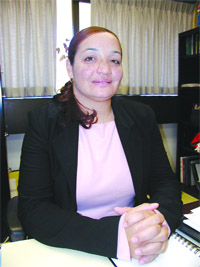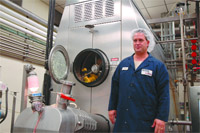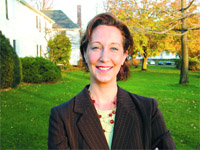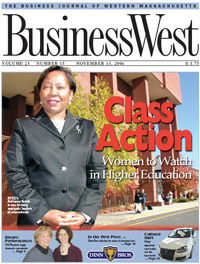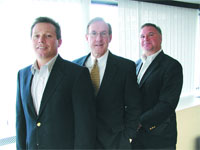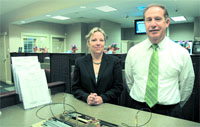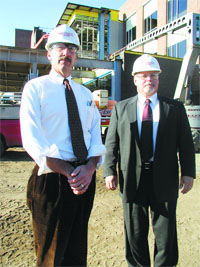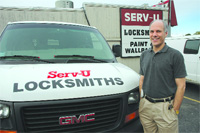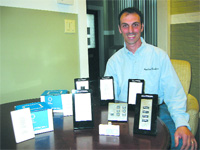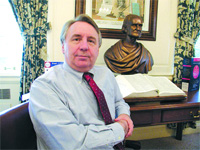New York-based Barr & Barr Inc., which counts many elements of Rockefeller Center among its first projects, has, over the past 80 years, compiled a solid reputation in the health care and institutional fields of construction. It made its entry into the Western Mass. area several years ago with work at Williams and Amherst Colleges and, later, Holyoke Medical Center. With that beachhead secure, the company has aggressively gained market share, and has some ambitious plans for the future.
Interaction.
That was the initial, one-word response offered by Steve Killian when asked what distinguishes construction work for the health care industry from, say, that for a college dormitory, parking garage, or office building.
“It’s the give and take between the builder, the architect, the client and the subcontractors to make sure the user knows exactly what their getting, and it’s what they want,” said Killian, senior vice president of Barr & Barr Inc., the 80-year-old New York-based firm that has planted roots in Western Mass. and has built its reputation on, among other things, expansions and new construction for health care providers.
This give and take, as Killian called it, is merely part of an operating model known in the industry as ‘construction management at risk,’ or CM at risk. The CM designation differentiates Barr & Barr from general contractors, or GCs, he explained, and ‘at-risk’ denotes, as the phrase implies, that the builder is assuming some degree of risk.
Specifically, that risk involves the price bid for the project in question, Killian continued, adding that this bid becomes a guarantee of sorts that the price for the work will not exceed that number. And if it comes in lower — something that actually happens in this industry when most, or everything, goes right — then the difference is returned to the client, unless it wants to put it back into the project.
“It’s a model that’s worked very well for us, and it is fairly unique,” he said, noting that there are several versions of the CM delivery method that provide varying levels of risk for construction firms. “It makes us partners with the client, the architect, and subcontractors, and that’s why it’s such an effective method.”
The CM-at-risk operating platform, used for about 90% of its projects, coupled with the company’s reputation — it has handled work ranging from renovations of Radio City Music Hall to hundreds of millions of dollars worth of projects for New England Medical Center in Boston — has enabled Barr & Barr to make a large and rather immediate impact on the Western Mass. market.
It started five years ago when the company successfully landed projects at Amherst College (some new dormitories) and Williams College (its new $50 million Center for Theatre and Dance, and the push into the Pioneer Valley gathered steam when Barr & Barr was chosen to handle a $12 million expansion at Holyoke Medical Center.
After establishing an office in an area on Hampden Street in Springfield, the company soon added to its Western Mass. portfolio. In 2004, the company was awarded a $40 million expansion at Cooley Dickinson Hospital, the largest single project in the hospital’s history, and, more recently, was chosen for a $14 million expansion at Mercy Medical Center, a $12 million renovation/addition at Franklin Medical Center in Greenfield, and the $9 million parking garage built at Baystate Health’s corporate offices in downtown Springfield.
“When we first looked at this market, we saw some real potential, and we’re seeing that potential realized, ” said Killian, who joined Senior Project Manager Bill Aquadro at the CDH construction site recently to discuss the company’s entry into the Western Mass. market and its outlook on the future. “Our plans now are simply to continue to grow within our identified niche areas — health care and institutional work.”
Building Momentum
As he led BusinessWest on one of the countless tours he has given of the new CDH facilities, now roughly six months from completion, Aquadro stopped in what will soon become one of the hospital’s new operating rooms and pointed to the ceiling, specifically to the mounts that will support lighting and other equipment.
“Technology has changed so quickly and so profoundly,” he started. “Today’s operating rooms have to reflect that. They need to be much bigger, because the technology is bigger, and they have to be built with the understanding that technology will continue to improve.”
This is part of that interaction process that Killian described, said Aquadro, who joined Barr & Barr recently after working for many years in his family’s business, Aquadro & Cerruti. The dialogue begins long before a shovel is put in the ground and continues until the client turns the key in its new facility, he continued, noting that the design of the one of the new patient rooms at CDH was altered recently after a nursing supervisor noted that the location of the nurse-call box wasn’t ideal.
“She said it should be moved,” said Aquadro, “and we moved it; we listened to what we were being told and made some adjustments.”
This ability to listen and respond has helped Barr & Barr build a huge portfolio of institutional and health care-related projects across the Northeast. Current health care projects include those at New York Hospital Medical Center in Queens (a $100 million modernization project), Memorial Sloan Kittering Hospital in New Jersey (a $41 million cancer center), Maimonides Medical Center in New York (a $73 million modernization), among dozens of others.
On the institutional/academic side of the ledger, current projects include work at the Massachusetts Institute of Technology, Yale University, Syracuse University, Colgate University, and Mount Saint Mary College in New York, among many others.
The client list (dominated with repeat customers, 80% of the total volume of work) and the geographic reach — from Northern New England to Southern New Jersey — has been eight decades in the making, said Killian, noting that the company was started in New York in 1927 by Joseph Barr. The company was first known as Barr & Lane, and later became Barr & Barr when Joseph’s brother, Donald, joined him.
Early work for the company, awarded by Nelson Rockefeller Sr., included the Time Life Building and Rockefeller Center’s Promenade, Garden, Center Theater, and its British and French Buildings.
The company continued to expand and diversify over the next several decades. Starting in the early ’50s, by which time the venture had passed to the next generation of the Barr family, it began to develop its reputation for work in the medical and education fields. It also expanded geographically, with a strong push into the Boston area — rich in both colleges and medical centers — and also Connecticut and, eventually, Northern and Western New York, Vermont, Maine, and the Pioneer Valley. The Philadelphia area is the next target, said Killian.
Barr & Barr’s list of offices speaks to its territorial expansion; locations include Springfield, Framingham, and Williams-town, Mass., New Haven, Conn., Syracuse, N.Y., Brunswick, Me., New York City, and Franklin Lakes, N.J.
Laying the Groundwork
The company had long eyed the Western Mass, market, also deep in medical, higher education, and cultural institutions, said Killian, and made its first foray into the region’s health care sector with the Holyoke Medical Center project, an initiative that included a new surgical suite, cardiac cath lab, and several renovations.
With that foothold, the company later added projects at several area institutions, and, as its reputation and referrals grew, so did the portfolio.
“Our expansion in this market is similar to what we did in the Syracuse area, Vermont, and Princeton, N.J.,” he explained. “You start with a project or two, like we did at Syracuse University, which led to more work at Colgate, Hamilton College, and other institutions, and keep building on that base.”
It was the strong potential for growth in the Western Mass. market that prompted Killian, who has been with Barr & Barr for 14 years, and was working at its Middlebury, Vt. office to relocate to the Pioneer Valley and essentially set up shop for the company here.
He attributes its quick success — more than $100 million in contracts over the past five years — to the company’s strong reputation, but also the CM at risk model, still rare within the construction industry, and especially the Western Mass. market. That operating style essentially makes the company partners with its clients, he explained. It applies a contractor’s perspective and input to planning and design decisions, and has the ability to fast-track early components of construction.
“By making the construction manager-at-risk a key member of the project team, responsibility for construction is centralized under a single contract,” he explained, adding that Barr & Barr’s project-delivery method has no doubt played some role in winning the projects at CDH, Baystate, and, most recently, Mercy Medical Center, institutions that have often used other area builders.
Describing the expansion project at Mercy, James Fanale, chief medical officer for the Sisters of Providence Health System, said it involves new and more modern facilities for the intensive care unit (ICU) and ambulatory services unit (ASU) and speaks to the many changes that are taking place in health care today.
“The people we have working in our ICU are terrific, they’re very talented, caring individuals,” he explained. “But the space … well, it just doesn’t work; the quarters are small and non-private — it’s the way things were done 40 years ago.”
Work to bring the hospital up-to-date and create space that does work has been ongoing for more than a year now, said Fanale, and in recent months has included discourse between the architects, Newton-based TRO Jung-Brannen, Barr & Barr, and both administrators and eventual end-users at Mercy.
The discussions involve everything from the size of the rooms to the colors on the walls to the amount of direct and indirect lighting.
“It’s all very scientific,” he explained. “There is a lot of detail that goes into how these facilities are going to feel and fit.”
The process has been similar at CDH, said Aquadro, noting that the company has been involved in all phases of this project, from the securing of new parking facilities — the addition swallowed up many existing spots — to the location of nurse-call boxes.
The interaction with hospital administrators and front-line employees starts early and is essentially constant, he explained, adding that, in the case of the new operating rooms (half again the size of the current facilities), Barr & Barr and the project’s architects built what he called mock-ups to determine how the rooms would look and what equipment goes where.
“They know what they want, and by doing these mock-ups, they know what they’re going to be getting,” he explained. “That way, there are no surprises.
“It all starts with a vision,” he continued, “for a healing, caring environment. A lot goes into that vision, from the amount of light in the room to access to nurses.”
Material World
Walking through what will be the new central sterile area in CDH’s ‘surgical tower,’ Aquadro said the codebooks that dictate how such facilities are to be built and operated are several inches thick.
This is another factor that separates construction in the health care realm from other types of building. “Those projects have codes that must be followed, too, he explained, “but it’s nothing like this.”
Helping clients meet all those codes, and turn vision into reality, is one of the traits that has enabled Barr & Barr to secure its reputation — and make an already significant impact on the Western Mass. market.
The challenge now is to build on that portfolio.
George O’Brien can be reached at[email protected]



